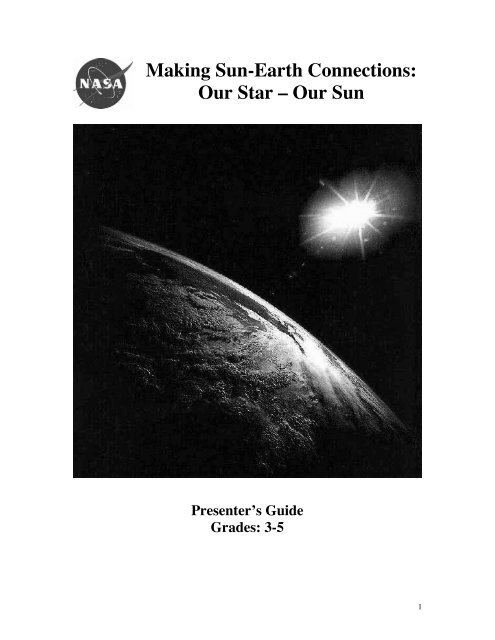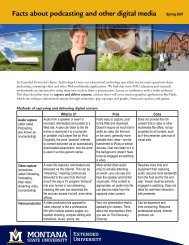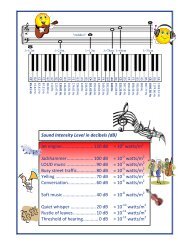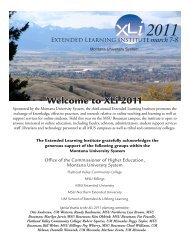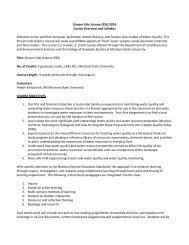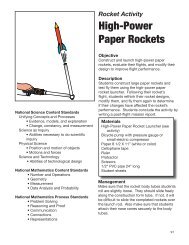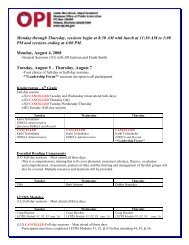Sun notes.pdf
Sun notes.pdf
Sun notes.pdf
You also want an ePaper? Increase the reach of your titles
YUMPU automatically turns print PDFs into web optimized ePapers that Google loves.
Slide 7Click on each image below to see the <strong>Sun</strong>’s active surface!The solar flares are theoutbursts of hot particles thatblast materials from the stormsinto space. The explosions areequal to millions of volcanoesexploding.7Slide 8Earth Is Shown ForSize ComparisonThe large angry outbursts ofplasma are the CME’s(coronal mass ejections).There are more of them whenthe <strong>Sun</strong> is very active (solarmaximum).8Slide 99Click on the image below tosee the video clip.19921996Solar Cycle1850 1860 1870 1880 1890 1900 1910 1920 1930 1940 1950 1960 1970 1980 1990 2000The <strong>Sun</strong>’s changes follow acycle just like our day followsour night. Approximatelyevery eleven years, the <strong>Sun</strong>follows a pattern. When it isvery active making energy, itis called solar maximum;when it is less active, it iscalled solar minimum5
Slide 1010Click below to see animation.Our Earth is like a giantmagnet; it has a magnetic fieldaround it called themagnetosphere. The CME’shit the Earth’s shield and someparticles pass through to makechanges in the Earth’ssurroundings.Slide 11The solar wind consists ofplasma that is continuallybeing released from the <strong>Sun</strong>.Click on each of the images below to see the animations.The matter blasted out of the<strong>Sun</strong> is somewhat like the windblowing. This stream of tinyparticles is called “solar wind”.It takes 1 to 5 days for thiswind to reach Earth.11Slide 12View From EarthSometimes the solar windcauses beautiful lights in thenight sky, called auroras.View From Space126
Slide 13Click on the image below to see the video clip.Astronauts need to wear suitsto keep them safe especiallyduring the <strong>Sun</strong>’s busy time(solar maximum).13Slide 14Click on the image below to see the video clip.The space weather (solarwind) also makes it difficultfor the radio to work right,pilots to find their way andmay even cause power failures.14Slide 15Why study the <strong>Sun</strong>? Our <strong>Sun</strong>is changing. During activetimes as well as less activetimes it makes energy thataffects our Earth and itssurroundings.157
Glossary of terms:Grades 3-51. Astronaut-a person traveling in space.2. Aurora-bright colorful lights formed by action of solar wind particleswith the Earth’s magnetosphere exciting gas molecules in the air.3. Corona-the <strong>Sun</strong>’s atmosphere.4. Coronal Mass Ejections-the gigantic plasma eruptions from the <strong>Sun</strong>’scorona.5. Convection Zone-part of the <strong>Sun</strong> where plasma moves up and down likewater in a boiling pot.6. Cycle-a pattern7. Magnetosphere-area around the Earth where magnetic field lines controlthe movement of charged particles.8. Photon-packet of light energy9. Photosphere-the visible part of the <strong>Sun</strong>.10. Plasma-a fourth state of matter made up of positively charged particlesand negatively charged electrons.11. Satellite-a free-flying object that orbits the Earth.12. Solar Flare-an explosive release of energy from the <strong>Sun</strong>.13. Solar Maximum-time period of an increase in <strong>Sun</strong> activity (energyrelease).14. Solar Minimum-time period of a decrease in <strong>Sun</strong> activity.15. Solar Wind-a constant flow of plasma expanding from the corona intointerplanetary space.8
16. Star-a celestial object that produces energy from nuclear fusion reactionsoccurring in its core.17. <strong>Sun</strong>spot-a region on the <strong>Sun</strong>’s surface that is darker and cooler than thesurrounding region. It has a very active magnetic field.9


